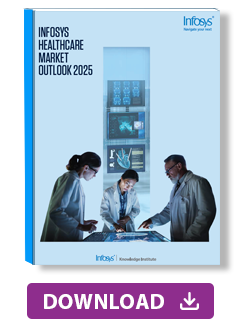Insights
- The US healthcare system faces challenges on the cost, access and equity fronts.
- Technology continues to accelerate, and healthcare enterprises struggle to keep pace.
- Workforce challenges loom.
- AI adoption holds potential but requires investment and training.
Executive summary
The US healthcare system has struggled to deliver high-quality, efficient care at scale across the broader population. While costs have escalated beyond those in other advanced economies, equitable access to care in the US remains elusive. Healthcare providers struggle with administrative burdens, burnout, and workforce shortages. Payers are working to improve patient experience, and to increase operational efficiency across complex systems.
In addition to these longstanding challenges, healthcare in the US faces new headwinds. As political decisions scale back investment in health research and public healthcare, they often impose additional regulatory constraints — just as healthcare organizations face mounting pressure to keep up with fast-moving technological innovation.
However, there are opportunities to address both recent headwinds and persistent challenges. New operating models that refocus on patient care and well-being offer a chance to reset. Digital modernization can reduce administrative burdens and potentially curb costs and delays in the system. Plus, artificial intelligence (AI) tools in healthcare hold the potential to unlock significant value — streamlining clinical workflows and enabling providers to focus on more meaningful, human-centered patient care.
Healthcare dynamics
The mission of a healthcare system is to deliver high-quality care to the widest population possible in an efficient manner. Healthcare systems in the US and globally have significant opportunities to advance across all of these dimensions.
The US healthcare market is the world’s largest in terms of spending as a percentage of gross domestic product (GDP), accounting for 17.6% of the nation’s GDP in 2023 (Figure 1). It also continues to grow faster than the overall economy.
Figure 1. Healthcare spending as percentage of GDP by country
Source: World Bank
Healthcare spending in the US grew to $4.9 trillion in 2023 and is projected to grow at more than 8%, according to the U.S. Centers for Medicare and Medicaid Studies. US healthcare spending per capita far outpaces other countries (Figure 2).
Figure 2. Healthcare spending per capita by country
Source: World Bank
But US healthcare is delivered unevenly and unclearly. Patient satisfaction and trust in healthcare institutions have been steadily eroding, signaling deeper concerns about transparency, access, and the overall patient experience. Meanwhile, US healthcare providers struggle to balance quality patient care and complying with processes.
Public dissatisfaction with healthcare systems is widespread. Americans typically trust their own physicians but distrust the healthcare system writ large. The tragic shooting of UnitedHealthcare CEO Brian Thompson in Manhattan — and the public response to it — underscores the deepening erosion of trust in healthcare companies and institutions.
Recent political and legislative actions have created new challenges and greater uncertainty in the healthcare space.
The US administration has cut billions in healthcare research funding from the National Institutes of Health and from research universities. Growing public skepticism and potential shifts in access to routine vaccinations are poised to compound the challenges already confronting healthcare providers.
Federal legislation enacted in July signals a significant shift in the US healthcare landscape, introducing looming budget cuts alongside sweeping changes to regulatory and compliance frameworks, particularly the One Big Beautiful Bill Act. While some of the 16 million Americans projected to lose coverage under the legislation may have gained insurance through more recent expansions — such as the Affordable Care Act (ACA) or pandemic-era provisions — these programs have become integral to the nation’s healthcare safety net. Reversing them risks undermining more than a decade of progress in healthcare access and affordability. It more generally reduces Medicaid eligibility, shortens enrollment periods and imposes other new requirements on enrollees.
Workforce challenges
Even before these new political challenges, the healthcare industry faced a serious workforce challenge. The staffing shortage spans the range from new technicians to medical professionals. According to the National Center for Health Workforce Analysis, the US could face a shortage of more than 187,000 physicians by 2037 — a projected gap that poses serious risks to care accessibility, quality, and system resilience. In addition, all caregivers are grappling with burnout and low job satisfaction. Nurses and allied health professionals report facing the same challenges as doctors, with additional frustrations in dealing with administrators and receiving abuse from patients.
Changes in care and operating models offer potential ways to address these workforce issues. As noted by Infosys and other sources, the prevailing fee-for-service model discourages integrated care and contributes to higher costs and lower efficiency. A value-based care model shifts the focus to patient health outcomes and quality rather than quantity of procedures.
Technology challenges
The mission of healthcare is complex and involved. Too often, this complexity means that understanding and adopting new technologies often get ignored.
Healthcare is consistently behind in technology adoption. In addition to outdated equipment, complexity and fragmented systems make technology tasks tougher. Even years after adoption of electronic health records, healthcare is one of the few environments where fax machines still have relevance and regular use. To be sure, interoperability concerns make fax machines practical, but the use of faxes is demonstrably inefficient and creates great potential for data protection challenges.
Even in instances where healthcare organizations wish to advance technology adoption, policy, regulation, and interoperability concerns impede their progress. First, any new data management systems and processes must comply with HIPAA, the US healthcare privacy law written in 2003. So new systems using AI must abide by data privacy and security rules that were written four years before the first iPhone shipped. Admittedly, updates to modernize HIPAA security rules are pending with federal healthcare authorities, and a range of incremental changes have been made in the past two decades.
Most healthcare providers could benefit from technology upgrades. The American Hospital Association, in a pitch for federal grants and loans to upgrade infrastructure, technology, and facilities, notes that more than one-third of rural US hospitals have physical plants that are at least 15 years old.
Further, the global healthcare system is highly vulnerable to cyberattacks. In 2024, a United Health subsidiary was hacked, and bad actors stole terabytes of patient data.
Despite these obstacles, healthcare technology spending is set to increase as companies depend on cloud-based technology for sophisticated solutions, address security vulnerabilities, and manage growth. That includes managing electronic health records in the cloud and trying out AI-backed software and solutions.
These headwinds will shape the near future of healthcare in the US. But of all these challenges, keeping pace with technology is the one challenge where healthcare organizations have the most agency and available remedies.
Tech and business trends
The road to modernization
Better integrated operating models rely on interoperability and coordination across the healthcare value chain. Yet still, three out of five US hospitals rely on legacy systems for at least one critical function.
The key to overhauling legacy systems lies in cloud-native transformation. Some 46% of healthcare organizations are partnering with cloud hyperscalers such as AWS, Microsoft Azure, and Google Cloud Platform to manage data and modernize infrastructure.
Cloud systems enable modular systems and microservices architecture. When implemented, these allow for faster innovation, and easier integration, and they also reduce silos and the risk of vendor lock-in. Organizations are adopting flexible plug-and-play tech stacks that allow for quick deployment and rapid experimentation. For example, Infosys is working with a leading payer to build their data pipeline on the cloud to enable rapid use of AI in their workflows.
Modern technology systems also allow healthcare providers to experiment with new ways to deliver care. Atrium Health used digital integration to establish a hospital-at-home system, which extends care from the hospital and clinic via digital devices linked to electronic health records. The program delivered care at a cost 20% lower than conventional monitoring and screening, according to a case study by the American Medical Association.
In addition to enhanced capabilities, digital modernization allows healthcare organizations to strengthen their resilience against cyberattacks. Bringing a cybersecurity-first design approach to modernization allows organizations to prioritize data encryption, deploy zero-trust frameworks, and automate compliance.
AI in healthcare
Care-oriented operating models and digital modernization are critical opportunities for healthcare organizations, but pale in comparison to the opportunities coming with the integration of AI into healthcare systems.
Research from Infosys released in early 2025 finds that enterprises have moved beyond experimenting with AI and have put it to work at scale.
For healthcare organizations, nearly half of those AI initiatives deliver value. That’s slightly behind the average and highlights a distinction in the healthcare sector. As tech healthcare consultant Lauren Bevan points out, the tricky part is getting an AI pilot project in production and delivering results.
AI agents have emerged as a useful tool in automating tasks in clinical settings. For example, the Mayo Clinic has begun using AI agents to assist in radiology. This institution is finding agents with human oversight can accelerate diagnoses and improve accuracy.
AI agents also can reduce the administrative burden on clinicians and allow them to focus more on patient care. Microsoft has trained ambient AI products that assist patient visits by listening in and summarizing interactions. This tool reduces administrative burdens and leads to more personable exchanges with physicians, the company says. More specifically, Microsoft says 70% of clinicians using ambient AI report an improvement in work-life balance, and 80% agree that it reduces their cognitive burden. Some 93% of patients surveyed say their physicians using ambient AI are more personable and conversational. more personable and conversational.
On the payer side, AI adoption is driven by its potential to make operations and care processes more efficient, to improve patient interactions and experience, and automate routine processes.
For example, a large US healthcare payer is implementing AI to address healthcare disparities and transform its patient contact centers. A Medicaid managed care plan operator has launched an AI program using predictive analytics to improve efficiency, reduce costs and detect fraud.
And another payer that specializes in government-sponsored programs is working to adopt AI across its technology systems to gain efficiency and improve quality of service. This program aims to use AI agents to connect and integrate systems across platforms. AI agents can handle tasks including prior authorizations, eligibility checks and claims processing with a lighter human touch.
AI-enhanced devices and robots are at the early stage of enhancing and revolutionizing patient care. Devices, robots, and the data they can passively gather can play a larger role in patient monitoring and give caregivers more data and earlier insights to act upon.
In addition to smoothing workflows and enhancing care, AI can help improve patient safety by keeping watch in the background for potential bad drug interactions or inadvertently missed tests or therapy options. It can also be used in monitoring patients and care systems. An AI-powered early warning system developed at Johns Hopkins University has reduced sepsis-related deaths by 18% at hospitals where it has been implemented.
AI needs guardrails
In healthcare, AI needs robust guardrails. This begins with responsible AI frameworks that ensure fairness, transparency, and accountability. Responsible AI for healthcare must also align with clinical standards and ethical practices.
For example, the Cleveland Clinic emphasizes bias mitigation and ethical AI use in its AI-related diagnostic tools. It has a cross-functional AI ethics board that oversees model development and monitors deployment and operations.
High-quality, well-governed data is an essential part of responsible AI practices. And as much as automation can manage routine tasks in health systems, maintaining human oversight on AI processes is essential. While AI can offer guidance, care decisions must remain with clinicians.
Above all, AI tools in healthcare must be developed with a clear purpose in mind and the healthcare mission at the center.
Financial outlook
Healthcare payers in the US include public-sector entities, most notably Medicaid and Medicare, and a consolidating pool of large health insurers, including United Healthcare, Elevance Health, Molina Healthcare, Cigna, Humana, and CVS Health (Figure 3).
Figure 3. For-profit healthcare payers by net earnings margin, most recent fiscal year
Source: SEC filings
While each of these insurers covers millions of Americans, they grapple with financial and operational strain. Enrollment in Medicare increased 10% in 2024, but Medicare premiums paid declined 9%. Payers manage net earnings margins of 5% or less, according to regulatory filings, and have been consolidating. The American Medical Association has repeatedly noted that high levels of local market concentration can hurt quality of care and leave consumers with few options.
In January, debt ratings agency S&P Global revised its outlook for US health insurers to negative from stable. The ratings agency projected stress and uncertainty driven by legislative and regulatory pressure as near-term challenges but noted that insurers have strong balance sheets that should help them endure.
Healthcare providers continue to consolidate into larger and larger healthcare/hospital systems. The nonprofit Kaiser Family Foundation tracked 1,573 hospital mergers between 1998 and 2017, and 428 hospital-health system mergers between 2018 and 2023. And standalone doctors’ offices have dwindled. The share of physicians working for hospitals or in a practice owned in part by a hospital or health system increased to 41% in 2022, up from 29% in 2012.
Strategic imperatives
Despite new headwinds and persistent challenges, healthcare organizations see opportunities for improvement on the horizon. These exist at the intersection of human care and technological change. On the human side, the time is ripe for systemic change in operating models that reorient healthcare to the patient-doctor relationship and focus on healthy outcomes and “healthspan” over procedures and lifespan. On the technology front, digital modernization and systems integration have become more feasible and the benefits more compelling. And finally, across operating model changes and infrastructure upgrades, AI offers potential for automating processes, managing details, and permitting caregivers to focus on care over compliance.
Analysis from the Infosys AI Business Value Radar shows that 47% of AI initiatives from healthcare organizations achieved partial or most business value (Figure 4, which shows values for the most pursued use cases). Also, a slightly higher proportion of AI initiatives in healthcare fail to achieve any value or are canceled after deployment. And a slightly higher proportion of AI work remains in planning or pilot phases. Pilots are a key part of the AI strategy for organizations as it allows them to evaluate the benefits and risks of leveraging proprietary data. Healthcare businesses are conducting proofs of concept to integrate AI into their operational workflows. In one instance, AI in a healthcare system diagnostic setting cut report generation time by 92% and delivered interactive information.
Figure 4. Nearly half of healthcare AI initiatives achieved partial or most value
Source: Infosys Knowledge Institute
Sustained tech investment, digital modernization, and workforce training will be the keys to improving that performance, AI Business Value Radar data shows.
Operating models, digital modernization, and AI each contribute to return on investment. When implemented together and at scale, these people, technology, and innovation initiatives improve the ability of healthcare organizations to deliver on their mission of high-quality care to a broad population in demonstrably efficient ways. Based on this research, healthcare lags most industries in achieving business value (“viability”) from AI initiatives (Figure 5, where 1.00 is average viability).
Figure 5. AI in US healthcare is delivering less value than in other industries
Source: Infosys Knowledge Institute
Our research shows this deficit exists despite an abundance of AI training and AI literacy in healthcare. The AI Business Value Radar found that typically workforce training significantly boosts the viability of AI initiatives. A larger proportion of healthcare workers (22% versus 16% in all industries) have full support and engagement in AI training as defined by the report’s workforce readiness archetypes. In addition to the 25% designated trailblazers, an additional 27% meet the Pathfinders tier (Figure 6). Given this, other factors seem to be limiting AI's impact on healthcare thus far.
Figure 6. About half of US healthcare workers are prepared for AI
Source: Infosys Knowledge Institute
These constraints are rooted in structural and technical issues, including siloed digital systems and regulations and process complexity. Companies that invest in technology transformation alongside their AI initiatives more often achieve business value from AI, our research shows.
Oriented to care
As noted earlier, healthcare organizations that prioritize patient-centered value over traditional fee-for-service models are better positioned to achieve improved outcomes — both clinically and operationally. Value-based care puts a greater emphasis on primary care and preventive medicine, in contrast to high-cost specialist visits.
In concert with a focus on care, expanding digital health tool adoption can improve quality, convenience, and access to care. The Covid-19 pandemic led to a surge in the use of telehealth and remote digital tools, and the rewriting of rules to allow their clinical usage. This has proved a critical first step, and strategic health organizations will continue to integrate new digital tools to accelerate existing care processes and workflows.
Digital tools enable automation and speed, as well as personalization and behavior management. Personalized medicine or precision medicine enables more effective treatments and fewer patient side effects and has proved effective in cancer treatments. Consultants and technology solutions from data and AI companies to makers of wearables are hyping the promise of personalized medicine for all-purpose healthiness; its greatest impact thus far has been in specialized treatment areas such as oncology and cardiology.
Adjacent to quality care, healthcare organizations can put technology to work improving patient experiences. Patients in other contexts have come to expect high levels of personalization, responsiveness and clear communication. Healthcare organizations can benefit from putting personalization and digital tools to work, with the proper workflows.
Using patient-centered design creates a clear, personalized experience across all touchpoints. Better access to information and improved communications in all channels improve satisfaction and foster trust. This sounds obvious, but patient communication is an area where physicians feel overwhelmed, and in need of better processes to manage the portals and communications tools that patients and other stakeholders have at hand.
Modern digital infrastructure and new technologies are available to help healthcare providers deliver on their mission, but new tools will only yield limited benefits without thoughtful changes to operating models and workflows.
This is particularly true in the era of AI. As the AI Business Value Radar points out, getting real value from AI “will require leaders to take transformation of their business seriously. Our research identifies a strong link between AI success and the changes that a business makes to its operating model and data structures.”
Zero distance to the patient
Technology moves quickly, and AI tools will evolve rapidly. Regardless of specific tools, the most impactful AI innovations in healthcare will reduce the distance between caregiver and patient to zero.
The biggest factor in healthcare creating distance between caregivers and patient is administrative processes. Many of these processes are necessary for safety, compliance, and financial reasons.
However, when the process of getting a doctor’s visit scheduled, approved, and covered takes more time than actually delivering the care, it detracts from the patient's experience and creates more distance between the patient and their physician.
Operating model changes, digital modernization and purpose-built AI tools can reduce the time and energy spent on approvals and administrative activities.
With claims, processing and scheduling handled in the background, healthcare providers can bring the doctor and patient back to the center of care. The Mayo Clinic’s work in tailoring care and Microsoft’s Ambient AI system are both instances where the technology draws the doctor and patient closer together.
Technology brings change. And in healthcare, technology applied thoughtfully can bring about a new era of primary care and better ways to fulfill the healthcare mission.












